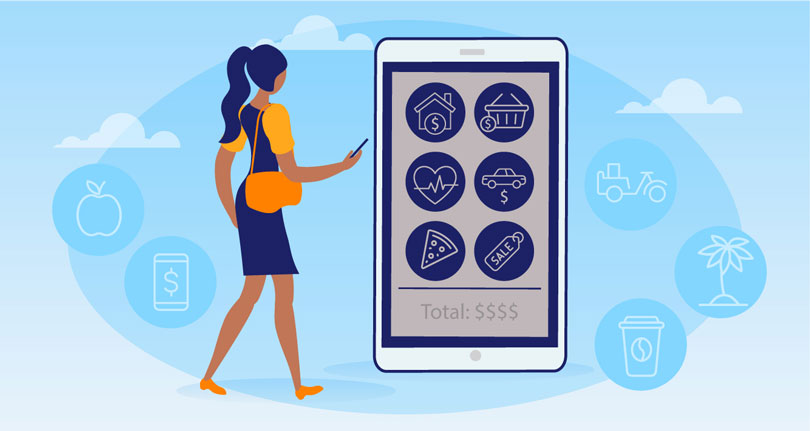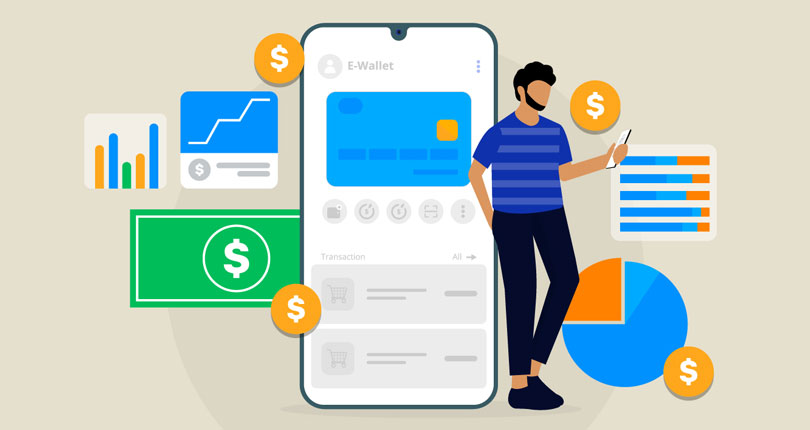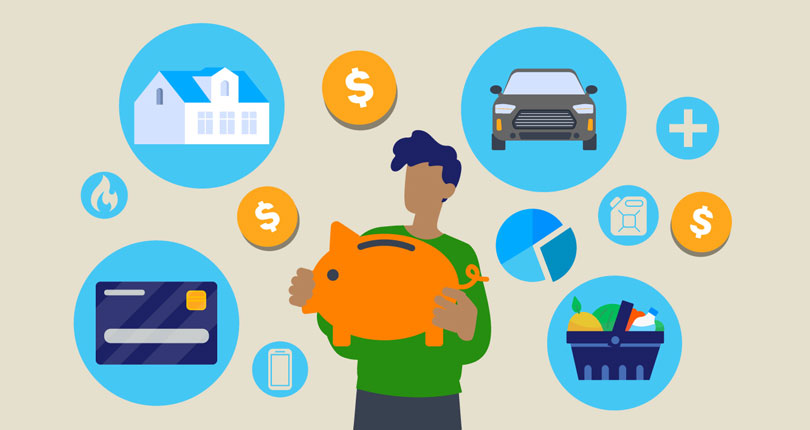Gen Z Financial Habits: Spending and Saving Stats
The cost of living can impact different generations in a variety of ways, but how do today’s young people manage their spending and saving? A survey was conducted on behalf of Self around Gen Z financial habits to see what this group is spending money on, how much they’re saving, and what their biggest money worries are.
Who are Gen Z?
Generation Z is the name given to people born between 1997 and 2012. According to 2022 data from Statista, Gen Z makes up 20.7% of the U.S. population with over 69 million people in this age group.
This makes them the second-largest generation group in the U.S., following millennials (21.6%) and just slightly ahead of Baby Boomers (20.5%). [1] Statista - U.S. Population By Generation https://www.statista.com/statistics/797321/us-population-by-generation/
Key Statistics
- The estimated average amount that people in the Gen Z age group have in savings is $2,410.57 compared to around $23,000 for Millennials and $156,000 for Baby Boomers.
- Gen Z is the second-largest generational group in the U.S., behind millennials.
- The estimated average annual earnings for Gen Z are $22,924.68, or $1,910.39 per month.
- Gen Z spend most of their money on household bills and expenses, with 52.3% saying they spent the most money on these costs.
- 17.2% of Gen Z don’t think they’ll ever have enough money to buy their own home.
- The estimated average amount Gen Z spends on socializing is $166.75 per month, totaling $2,000 a year.
- 93.2% of people in the Gen Z age group said they had bought items after seeing them on social media.
- Over half (51.5%) of Gen Z said they mostly shop online when buying clothes and gadgets.
How much does Generation Z earn?
With Gen Z being quite a wide-ranging age group, earnings can vary from teenagers who get a weekly or monthly allowance, to those in their mid-20s with a degree and a full-time job. The findings show that Gen Z respondents earned an estimated average of $1,910.39 per month, with an annual average of $22,924.68.
The most common monthly earnings among respondents were between $501-$1,000 per month, with 29.3% saying they earned this much. However, around half (54.9%) said they earned between $501-$2,500 per month.
Side hustles
The survey also asked respondents whether they have a side hustle, defined as an extra source of income outside of their main occupation. Over four in five (81.9%) of Gen Z said that they do have some form of side hustle.
This links back to data from a side hustle study, which found that 70% of people aged 18-24 were planning on starting a side hustle. It also found that those aged 18-24 were making an average of $533.43 per month from their side jobs, or just over $6,400 a year.
Living situation
When asked about their current living situation, the most common answer was living at home with parents or family, with 39.4% of the group. However, 43.5% said they rented a property, either on their own, with roommates or with a partner. Only 16% of Gen Z said they owned their own home.
| Current situation |
% |
| Live at home with parents or family |
39.4 |
| I rent a property on my own |
20.7 |
| I rent a property with a partner |
17.1 |
| I rent a property with roommates |
5.7 |
| I own my property |
16 |
| Other |
1.1 |
What do Gen Z spend money on?
Recent reports suggest that Gen Z has a spending power of an estimated $360 billion. [2] The Shelf - Gen Z Spending Habits https://www.theshelf.com/the-blog/gen-z-spending-habits/ But what do people in this age group spend their money on?
With Gen Z’s ages ranging from young teens to mid-20s, there’s a mixture of things they are most likely to spend their money on. Some will get most of their money in the form of an allowance, some might have part-time jobs, and others may work full-time and live in their own home. Let’s take a look at the breakdown of spending.
In the survey, respondents were able to select more than one answer for the things they spend the most money on. From the people surveyed, the most common thing they spent their money on was household bills and expenses, and this was closely followed by clothes and accessories.
| Type of spending |
Percentage |
| Household bills and expenses |
52.34% |
| Clothes and accessories |
44.07% |
| Going out/entertainment |
37.49% |
| Food delivery/eating out |
36.99% |
| Toys and games |
15.45% |
| Travel |
38.78% |
| Online services |
16.75% |
| Personal care |
17.65% |
| Sports or gym |
11.47% |
| Healthcare products/medication |
13.96% |
| Technology |
11.76% |
| Paying off debt |
8.47% |
| Student loans |
7.78% |
| Other |
2.99% |
Household bills and expenses
When asked how much they typically spend per month on household expenses including things like rent and bills, the average amount Gen Z said they spent was $613.05, which is $7356.60 per year. Around half (52.6%) said they spent between $51 and $600 on these costs. The most common answer was $101-$300 with 21.1% of the group.
On the highest end of the scale, only 2.9% of respondents spent over $2,000 per month on household bills and expenses, while 3.8% said they spent nothing at all on these types of costs.
| Money spent on household bills per month |
% |
| $0.00 |
3.79 |
| $1 - $50 |
9.17 |
| $51 - $100 |
13.46 |
| $101 - $300 |
21.14 |
| $301 - $600 |
18.05 |
| $601 - $1,000 |
15.25 |
| $1,001 - $1,500 |
11.37 |
| $1,501 - $2,000 |
4.89 |
| $2,000+ |
2.89 |
Spending on entertainment
The estimated average amount Gen Z spent on entertainment was $157.07 per month, amounting to $1,884.84 per year, which includes streaming services, music, gaming and similar products. However, one-fifth (20.4%) of the group said they spent between $21 and $50 on entertainment. Across the group, almost two-thirds (61.3%) said they spent between $1 and $110 on entertainment.
A small percentage (0.8%) said they spent over $1,000 per month on entertainment, with 2.5% saying they spent $700 or more.
| Money spent on entertainment per month |
% |
| $0 |
3.99 |
| $1 - $20 |
13.46 |
| $21 - $50 |
20.44 |
| $51 - $80 |
13.86 |
| $81 - $110 |
13.46 |
| $111 - $150 |
11.76 |
| $151 - $200 |
8.28 |
| $201 - $300 |
4.49 |
| $301 - $500 |
5.18 |
| $501 - $700 |
2.59 |
| $701 - $1,000 |
1.69 |
| $1,000+ |
0.80 |
Spending on social events
When it came to spending on socializing like eating out or going to a bar or club, the estimated average amount Gen Z spent was $166.75 per month, or just over $2,000 per year.
To break it down, 16.7% of respondents said they spent between $21 and $50 per month. But across the entire group, over two-thirds (67.5%) spent between $1 and $150 on socializing each month.
| How much Gen Z spend on socializing per month |
% |
| $0 |
4.89 |
| $1 - $20 |
10.07 |
| $21 - $50 |
16.75 |
| $51 - $80 |
13.96 |
| $81 - $110 |
13.86 |
| $111 - $150 |
12.76 |
| $151 - $200 |
11.47 |
| $201 - $300 |
6.28 |
| $301 - $500 |
3.59 |
| $501 - $700 |
3.49 |
| $701 - $1,000 |
1.69 |
| $1,000+ |
1.20 |
Shopping for clothes, cosmetics and gadgets
Survey respondents were asked how much money they typically spend on shopping for clothes, cosmetics, gadgets and similar items each month. The estimated average amount Gen Z spent on these items was $178.11 per month, a yearly sum of $2137.32 per year.
More than half (54.6%) said that their spending on clothes, cosmetics and gadgets was between $1 and $110 per month. 1.3% of the group even said they spent over $1000 per month on shopping for these items.
| How much Gen Z spend on shopping (clothes, cosmetics, gadgets) |
% |
| $0 |
4.89 |
| $1 - $20 |
9.47 |
| $21 - $50 |
14.46 |
| $51 - $80 |
15.85 |
| $81 - $110 |
14.66 |
| $111 - $150 |
11.76 |
| $151 - $200 |
9.57 |
| $201 - $300 |
6.08 |
| $301 - $500 |
6.28 |
| $501 - $700 |
3.49 |
| $701 - $1,000 |
2.19 |
| $1,000+ |
1.30 |
Where does Gen Z usually shop?
The majority of people in the Gen Z age group said they did most of their shopping online, with more than half of the group (51.5%) saying they mostly shopped online for their clothes, accessories and gadgets.
Making up most of the other half of the group were those who shopped at individual stores (21.8%) and those who mainly shopped at a mall (22.8%), while 4.1% said they mostly shopped at thrift stores. The remaining few respondents gave a mix of answers, stating that it depended on the item or that they used a variety of shopping options.
| Store type |
% |
| At individual stores |
21.83 |
| At the mall |
22.23 |
| Online |
51.55 |
| Thrift stores |
4.09 |
| Other |
0.30 |
Social media and buying habits
When looking at Gen Z’s personal finance habits, survey respondents were asked whether they ever bought products after seeing them on social media. Two-thirds (64.2%) said that they sometimes buy items they have seen on social media, 29% said they did this often, and only 6.8% said they had never bought an item after seeing it on social media.
| How often Gen Z buy items after seeing them on social media |
% |
| Never |
6.78 |
| Often |
29.01 |
| Sometimes |
64.21 |
A 2021 survey found that, in the U.S., 54% of Gen Z said they thought social platforms were more useful in helping them find out about new products than search engines. [3] Statista - Social Media Product Discovery By Generation https://www.statista.com/statistics/1252639/us-social-media-product-discovery-by-generation/
This was slightly lower compared to 58% of millennials, but much higher than Gen X at 29% and Baby Boomers at 3%.
How much does Gen Z have in savings?
The results of the survey showed that the estimated average amount Gen Z had in savings was $2,410.57.
Comparing this figure to other generations, Millennials have a median savings amount of $3,500 (not including 401(k) or similar plan), Gen X have $5,000 and Baby Boomers have a median of $25,000 in savings. [4] Transamerica - Multigenerational Workforce Report https://transamericainstitute.org/docs/default-source/research/post-pandemic-retirement-realities-multigenerational-workforce-report-july-2023.pdf
Just under a quarter (24%) of respondents said they had between $501-$1,000 in savings. This is roughly in line with the amount most Americans have in savings, with statistics showing that 41.5% of Americans have between $0 and $1,000 saved.
At either end of the savings scale, 5.2% of Gen Z said they had no savings at all, and 5.4% said they had over $10,000 saved.
| How much Gen Z has in savings |
% |
| $0 |
5.18 |
| $1-100 |
12.96 |
| $101-$500 |
22.43 |
| $501-$1,000 |
24.03 |
| $1,001-$5,000 |
20.04 |
| $5,001-$10,000 |
9.97 |
| Over $10,000 |
5.38 |
Emergency funds
As well as asking about their total savings amount, respondents were also asked whether they set money aside to cover the costs of emergency events. An overwhelming majority (85.3%) said they did save money specifically to use in an emergency.
A previous study found that the average amount a person spends on emergency spending in a period of 12 months is $2,821.84 so it’s a good sign that Gen Zers are already setting money aside to deal with these unexpected costs when they may arise.
Gen Z financial security
When it comes to financial security, this can mean different things depending on your circumstance. In general terms, having financial security or stability can mean you are able to pay your essential bills, you have access to safe housing, healthy foods and other necessities, and you’re able to plan for the future.
The survey asked respondents whether they felt financially stable. Two-thirds (66.2%) of those in the Gen Z age group said they did feel that they had personal financial stability. A quarter (26.8%) said they didn’t have financial security, and 7% said they didn’t know whether they did or not.
Gen Z debt statistics
With student loan debt on the rise and the cost of living increasing, this study looked into how many Gen Zers are in debt, and how much debt they’re in. It also found out how common it is for them to take out a loan, and what kind of things they take loans out for.
Student Loans
Student loan debt is on the rise with the total amount of student debt in the U.S. sitting at $1.77 trillion. [6] Student Loan Debt Statistics https://educationdata.org/student-loan-debt-statistics A recent study on behalf of Self found that the Millennial generation (age 25-34) had the most student debt, with 14.9 million borrowers, compared to 7.6 million Gen Z borrowers (aged 18-24).
Two-thirds (65.9%) of Gen Z survey participants said they had student loan debt.
Taking out loans
Many people may take out loans to cover unexpected costs, or for things like college tuition and car payments. Three-quarters (76.7%) of those asked said that they had taken out a loan of some sort.
Participants were asked if they had taken out a loan, what reason they had taken it out for, with the option to select all that applied to them. Not including student loans, the most common thing Gen Z had taken a loan out for was medical costs, with 34.3% saying they used a loan to cover these costs. Data from another study in 2022 also shows that 25% of Gen Z have skipped rent or mortgage payments because of medical debt obligations. [7] Younger Generations Hit Harder by Medical Debt https://www.medicaleconomics.com/view/younger-generations-hit-hard-by-medical-debt
This was followed by regular household expenses at 32.5% and home repairs at 29.1%. Some of the less common reasons people had taken a loan out included weddings, Christmas shopping and building credit.
| Reasons Gen Z have taken out a loan |
% |
| Medical costs |
34.3 |
| Regular household expenses |
32.5 |
| Home repairs |
29.1 |
| Car repairs |
28.3 |
| Pet emergency |
18.2 |
| Emergency travel |
17.1 |
| Other |
5.4 |
Are Gen Z worried about money?
Money worries can be normal for people of all generations, but how do Gen Zers feel about their finances, and which money worries cause them the most anxiety?
Survey respondents were asked how often they worried about money-related issues. One-third said they worried about money every day, with almost two-thirds (61.3%) saying they worried about money at least once a week.
Only 3.7% of those in the group said they never worried about money, and 8.3% said they only worried about money a few times a year.
| How often Gen Z worry about money? |
% |
| Every day |
33.60 |
| Once a week |
27.72 |
| Once a month |
26.72 |
| A few times a year |
8.28 |
| Never |
3.69 |
Financial concerns they worry about the most
The most common thing that Gen Zers said they worry about when it comes to their finances is saving money, with 29.5% saying this is what worries them the most. This was followed by household bills which a quarter (23.1%) said they worried about the most in relation to money.
One-fifth (19.1%) worried the most about paying for healthcare and medical bills. Only 7.6% said they worried the most about economic stability throughout the U.S.
| Financial concerns that Gen Z worry about the most |
% |
| Household bills |
23.10 |
| Healthcare and medical bills |
19.14 |
| Paying off debt |
12.21 |
| Saving money |
29.54 |
| Paying for college |
4.13 |
| Economic stability in the U.S. |
7.59 |
| Paying for a car |
3.14 |
| Home repairs |
1.16 |
Financial planning
As previously mentioned, almost all participants (96.3%) said they worried about money at least sometimes. They were also asked whether they did any kind of financial planning, 79.2% said yes, they did do some form of financial planning.
Gen Z and credit scores
Credit scores can have a big impact on the financial aspects of our lives, they affect whether we can buy a house, get a credit card, or be approved for a loan. Gen Z participants were asked how important they thought a credit score was on a scale of 1 - 5, with 1 being ‘not important at all’, and 5 being ‘very important’.
Over 80% scored the importance of a credit score as a 4 or a 5, with 41.97% saying it was very important. Only 1% of respondents thought a credit score was not important at all.
| How important do Gen Z think a credit score is? (Scale of 1 - 5) |
% |
| 1 - Not important at all |
1.00% |
| 2 |
2.69% |
| 3 |
13.36% |
| 4 |
40.98% |
| 5 - Very important |
41.97% |
Survey participants were asked whether they knew what their own credit score was. Over 90% said that they did know their own credit score.
More Gen Z finance statistics
Let’s take a look at some more statistics relating to Gen Z’s finances. [5] Gen Z Financial Goals https://www.rocketmortgage.com/learn/gen-z-financial-goals-2023
- One study found that 45.1% of Gen Z have set themselves goals relating to homeownership in 2023 with 27.3% saying they are saving for a house, but the most-expected obstacle to this goal is not having enough money saved for a downpayment.
- Seven in ten (69.1%) of Gen Z are currently saving money, but 42.6% admit to having spent more than they had earned at some point.
- The most common financial goal for Gen Z is increasing their income, with 39.5% saying this is something the aim to do this year.
- Half (51%) of Gen Z set themselves a budget for spending categories like food, rent, utilities, transport, and entertainment.
Methodology
The study surveyed 1,702 Americans between April 1st and April 24th, 2022 asking them about their financial habits. Of the respondents, 1,003 were in the Generation Z age group and all were over 18.
Of the other respondents:
- 58.6% were born between 1981 and 1996
- 31.1% were born between 1965 and 1980
- 10.2% were born between 1946 and 1964
- 0.2% were born between 1928 and 1945
Sources






